The Dunes Golf & Beach Club
South Carolina, USA
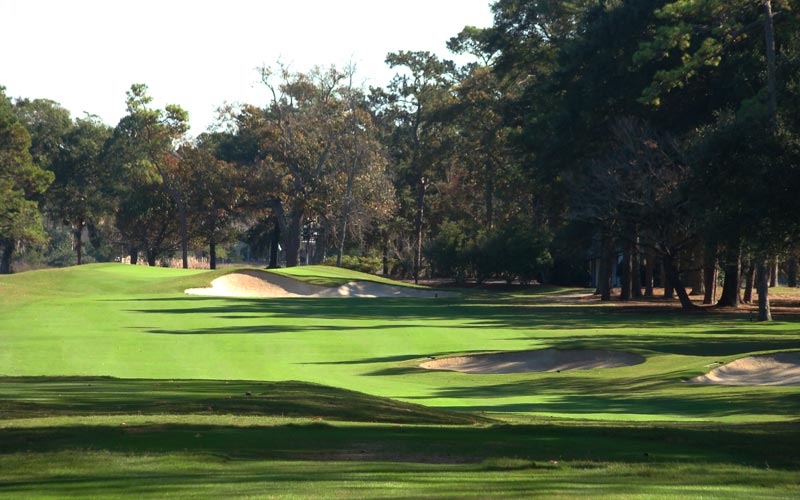
Thanks to its mature trees, rolling property, thoughtful bunkering and strategic use of other varied hazards, and built-up greens, The Dunes remains as popular today as when it opened in 1948. Hundreds of thousands of golfers have enjoyed it since, a lasting testimony to Robert Trent Jones Sr.’s skill as an architect.
The dean of modern golf course architects, Robert Trent Jones‘s career was groundbreaking. From being sought by a king in east Africa to designing a course on Sardinia for Aga Kahn to Spain to the dunes of Ballybunion, and across the United States of America including the Hawaiian islands, the range of sites upon which he worked is immense and the mark that he left behind around the globe is second to none. While The Dunes Golf Course was among the first dozen to open out of more than four hundred courses that bear his name, it may best highlight Jones’s views on golf course architecture to this day.
Born in 1906 in Ince, England, Robert Trent Jones was a true link from the Golden Age architects to the modern ones. He watched Donald Ross build Oak Hill in Rochester, New York where his parents had moved when he was three. Later, he joined Ross at the founding of the American Society of Golf Course Architects in 1946. Imagine sharing ideas with the likes of Ross, A.W. Tillinghast, William Langford, Perry and Press Maxwell! Robert Trent Jones greatly admired the work of Stanley Thompson and indeed became his partner after they met at a project at Midvale Golf and Country Club in Rochester. Thompson worked from Toronto and Robert Trent Jones in New York and their most famous project together was at Capilano where Robert Trent Jones deserves credit for the routing.
Some mistakenly call The Dunes Golf Course Robert Trent Jones‘s first significant original eighteen hole design but Peachtree Golf Club outside Atlanta preceded it by two years. In fact, thanks to his close relationship with the other Jones (Robert Tyre Jones!), he had already gained fame prior to The Dunes Golf Course by remodeling the eighteenth green and sixteenth hole at Augusta National in 1946. Shortly after building The Dunes Golf Course, he modified the eleventh at Augusta National and then prepared Oakland Hills to host the infamous 1951 United States Open Championship. From then until at least the early 1980s, he was the the biggest name in golf course architecture. Importantly, this was at a time when numerous golf course projects took flight based on the new found idea of matching golf course construction to real estate sales. Fortunately at The Dunes Golf Course, all the homes are on the perimeter and are mostly well set back from the course. No holes play through rows of homes and Robert Trent Jones captured the best features with his routing over the core property.
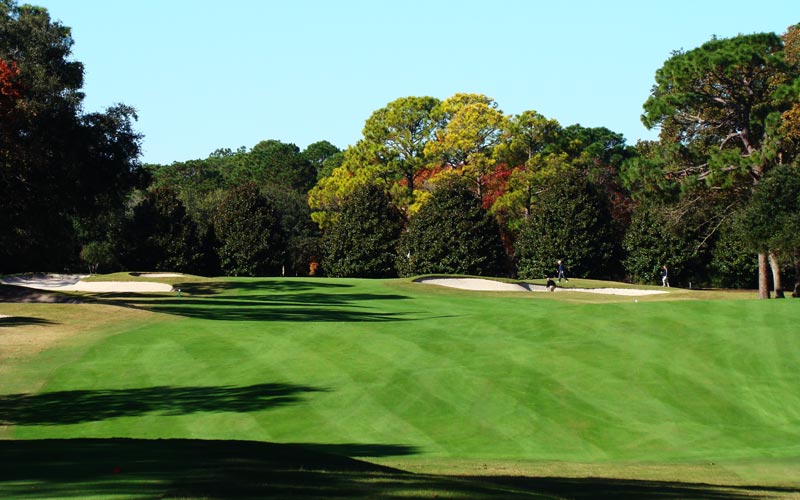
Though The Dunes doesn’t play through dunes, it was nonetheless a fine site for building a golf course. Jones’s routing made the most of the rolling landscape as here, for instance, the tee ball at the third ideally needs to reach the plateau on the far side of the fifteen foot deep valley.
Until the day he died in 2000, his passion for golf course architecture never dimmed. He was a true student of it as well as an effective writer and he detailed to the American public in various articles the difference between penal and strategic architecture. Personally, he embraced and coined the phrase ‘heroic’ architecture. As he wrote in Golf’s Magnificent Challenge published in 1988, ‘ I decided long ago that the better way was a design I labeled heroic, a concept that demands a heroic carry or gamble for the better player to get into position for birdie but one that leaves an option for the lesser player to take the safer route. There must be a just reward for those attempting the heroic carry, and there must be a way around those unwilling to take the risk. Without the alternate route, heroic carries are unfair. Without the reward, heroic carries are meaningless.’
While Robert Trent Jones said, ‘Every hole should be a difficult par and an easy bogey,’ more attention has been historically placed on the first part of the sentence rather than the last. Make no mistake: Robert Trent Jones very much believed in giving the high handicap golfer a chance to enjoy himself, calling architecture that didn’t ‘inept’ and ‘cruel’. This overall design philosophy – of heroic architecture, of challenging the best while keeping it fun for the rest -comes shining through at The Dunes Golf Course. Hence, it is an important and rewarding course to study, not to mention a delight to play.
Holes to Note
Second hole, 425/385 yards, Needle’s Eye; Brad Faxon once told the author that one of the reasons that he liked Harbor Town so much was because of the trees and how the overhanging branches made one shape the ball both ways during one’s round. Many of the other courses on the PGA Tour don’t require the golfer to work the ball, such is the sad state of the modern power game where brute strength and distance are more cherished than shotmaking and finesse. That being the case, Faxon would love the second hole here as the golfer who can shape his tee ball from right to left and/or hit it high enough to carry the live Spanish oak trees on the inside of this sharp dogleg left can have two or three clubs less into the green than the golfer who plays his tee ball straight ahead. Of course, golfers who are unable to work the ball are quick to grumble that the hole becomes a 210 yard lay-up off the tee, leaving them with a long hybrid shot into the green.

The bunker on the outside of the dogleg is 210 yards from the white markers and drives played toward it still leave a long shot in. Ideally, the golfer can draw his tee shot up and around the trees and be left with but a short iron for his approach.
Fourth hole, 505/465 yards, Temptation; Given the breadth of Robert Trent Jones‘s work over six decades, to try to categorize his work is both foolhardy and frequently misguided. Too many people falsely associate his design philosophy with the pinched fairway bunkers at Oakland Hills, not appreciating that was a unique, one-off commission for the express purpose of testing the world’s best. Robert Trent Jones‘s best original work features a high number of interesting risk reward options and angles of play and this hole is a prime example. Remember: This course was built in 1948. Augusta National and its gambling par fives had yet to register their full impact on the golfing landscape as the Masters wasn’t televised for years to come. Risk reward par fives featuring water hazards were still realtively few and far between. This hole roughly enjoys the same shape as the thirteenth at Augusta but in this case, a cluster of bunkers needs to be carried/contended with on the inside of the dogleg as opposed to a creek. Similar in distance to the thirteenth as well, a ten handicap who gets away a good drive can occasionally have a go at this green in two. For a wide range of skill sets, this is a very fun hole to play, so fun that it is almost a shame that it doesn’t come much later in the round where it would make a great swing hole.

If the golfer can bend his tee ball past two large fairway bunkers, he is left with a ~200 yard shot into this green. Pull it off and an eagle putt awaits!
Fifth hole, 205/180 yards, Ambush; Unlike many modern architects that followed him, Robert Trent Jones had a keen sense of economy and he moved dirt only where it mattered the most, especially in his early work such as here at The Dunes Golf Course. Take this hole for instance. While the space that it occupied was dead flat and featureless, he only built up a green pad and a tee area. Otherwise, he didn’t touch any earth. By doing so, he was able to give this hole good golfing qualities while it still ties off and fits with its surrounds. Congratulations to The Dunes Golf Course for the 2003 greens restoration by Rees Jones whereby A-1 bentgrass was installed and the bunker depth recaptured. There is plenty of dumbed-down golf on offer at Myrtle Beach but the club has never gone down that path.
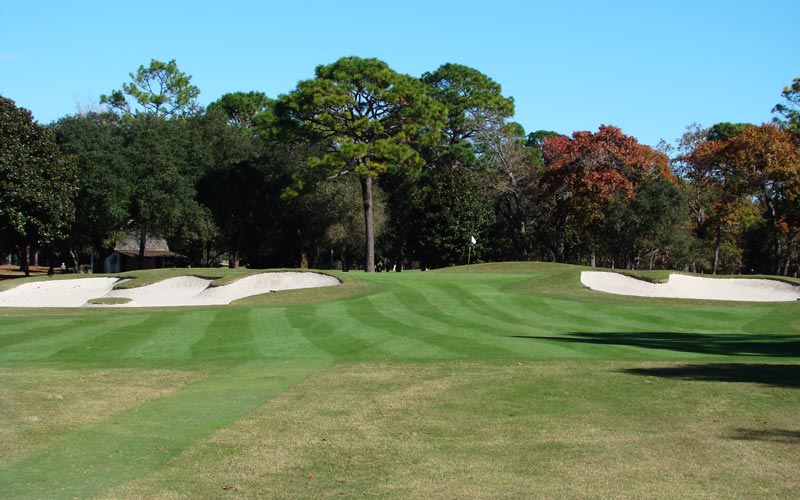
Jones built up the fifth green pad enough to cut two deep bunkers into its face. The putting surface falls away to the back left and the golfer with the skill to hit a shot of this distance with height enjoys an advantage.
Sixth hole, 465/415 yards, Devil’s Bite; The Dunes Golf Course plays much longer than its yardage indicates in part because the drives here, at the third, seventh, fifteenth and eighteenth holes all hit into upslopes in the fairway, thus killing much run. The golfer in turn has an uphill stance for his approach shot, which requires an additional club. In addition, his built-up green sites such as the one found here often times best reward the golfer who flies his approach well onto the putting surface. When taken together, these three playing characteristics stretch the course out, making it plenty of challenge for just about any event the club wishes to host.
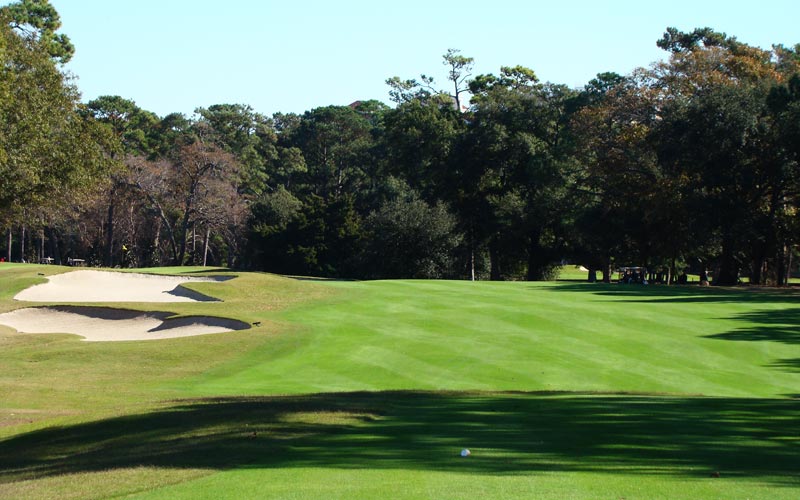
Jones built bunkers into the upslope of the fairway and the golfer needs to flirt with them in order…
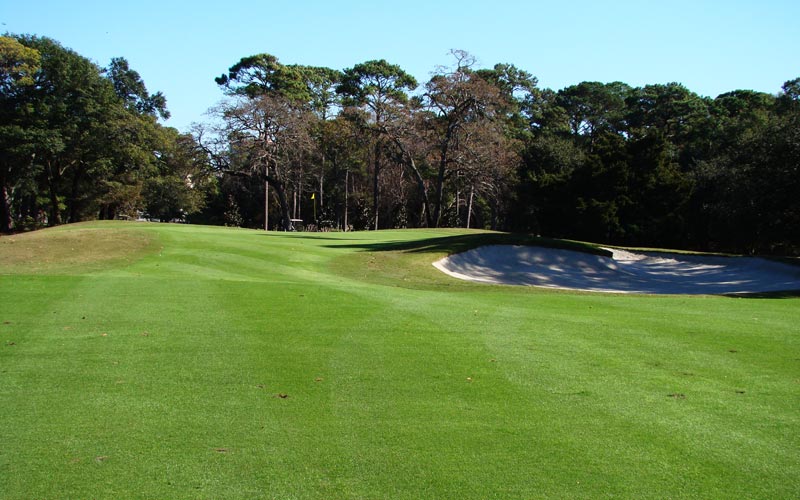
… to have the best angle into the pushed-up sixth green. Approach shots played from the right half of the fairway must contend with the right greenside bunker.
Ninth hole, 200/170 yards, Dunes; When viewing Robert Trent Jones‘s body of work as a whole, some lament the lack of ground game options. Essentially, many of his targets tend to be elevated and require some sort of aerial shot. Such is true with this one shotter but he had two very good reasons for doing so. First, the tall green pad helps block the sight of cars along the entrance road and second, the elevated green provides the best view of the Atlantic Ocean. In fact, it is the only real time that the golfer sees the ocean during the round (the back porch of the club is the place for superlative views), and this despite the fact that the majority of the course lies within 1,500 yards of the ocean. Subsequent developers of courses along the South Carolina coast (e.g. Harbour Town and The Ocean Course at Kiawah) set aside more water frontage than here and these newer courses that afford the longer, uninterrupted views have since stolen some of the spotlight away from The Dunes Golf Course.
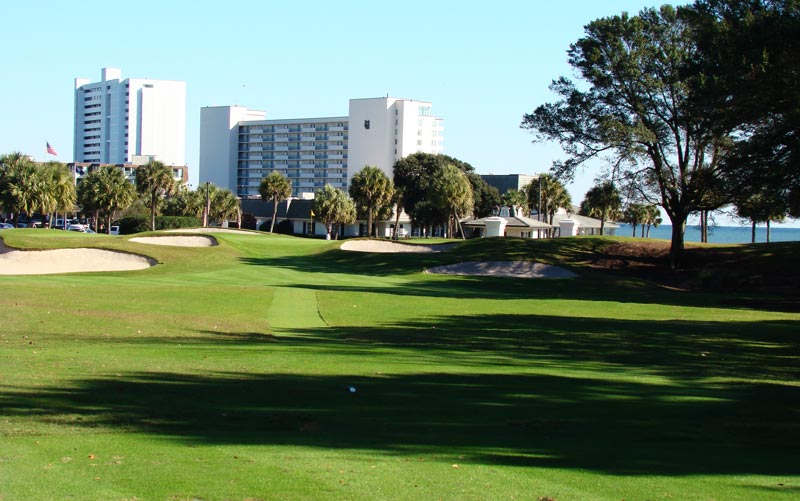
The low-lying understated clubhouse is in the near background but unfortunately the large hotel in the distance now dominates the view from the ninth tee.

The elevated ninth green is wide but only twenty-two yards deep. With four fronting bunkers, Jones’s design clearly calls for an aerial approach shot.
Eleventh hole, 430/385 yards, Salt Marsh; Though this hole doglegs right around Singleton Swash and though the green extends into the same hazard that the golfer contends with off the tee, this isn’t a true cape hole as a grove of trees are on the inside of the dogleg. Hence, the golfer doesn’t flirt with the hazard off the tee and indeed he needs to stay well away from them to have a clear second shot. Why not cut the trees down, you ask? The thought is that the hole would then just become a drive and a pitch, which is what the tenth hole is. With the trees forcing the golfer to the outside of the dogleg, this becomes one of the longer, more difficult par fours on the course which fits in nicely with the flow of holes around it.
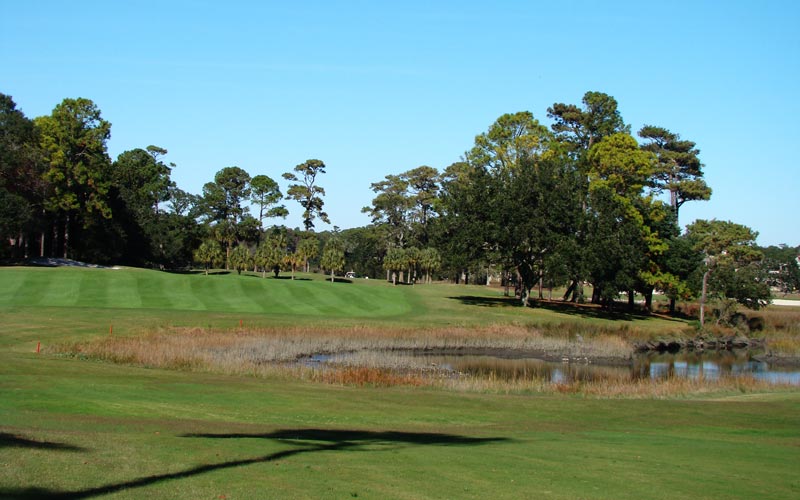
The tidal marsh becomes the dominant feature of the next two holes, though the trees on the inside of this dogleg right push the golfer away from it off the tee.

Protruding into the marsh, the eleventh green complex presents one of the most demanding targets on the course as its soft shoulders right and behind do nothing but help feed balls into the marsh.
Twelfth hole, 245/175 yards, White Heron; Jones considered flexibility a key tenet to good design and wrote that ‘Flexibility is created by the way the architect positions the tees, and the number of them, where he places the fairway hazards and of course, by the way he designs the green. A more difficult shot for the better player, an easier shot for the high handicapper is ideal. It is not always achieved, but it is a goal.’ He clearly achieved it here with the back markers requiring a taxing, all carry shot with a fairway wood across Singleton Swash while a tee ball played from the most forward of the five sets of tees can bumble along the fairway and onto the green without ever crossing the marsh.
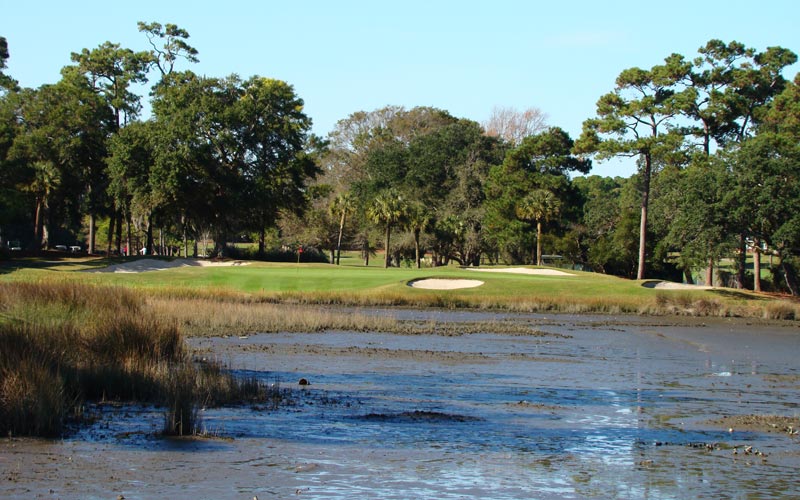
As seen above, the twelfth is a beast from the back, requiring a huge forced carry. The forward tees are kinder and provide progressively easier shots/angles into the green.
Thirteenth hole, 590/545 yards, Waterloo; Out of the 7,000 plus holes that Jones designed in over thirty countries, this one still might be his most famous single creation which would be fitting since it clearly embraces his heroic design philosophy. The tee ball is oddly uncomplicated for such a famous hole and little more than a straight shot of 220 yards is needed. Having done that, each golfer must then decide for himself how much of the thirty-five acre Lake Singleton to bite off on his second shot and the range in playing angles is staggering. It’s these options on the second shot that make the hole famous but the green itself is most noteworthy. Following the general slope of the hillside, the top left tier gives way to a lower right section and the contours are so strong that the golfer dearly loves to have nothing more than a short iron in his hand for his third shot. As with many iconic holes (the Road Hole at St. Andrews, the Alps at Prestwick, etc.), the thirteenth is not universally loved as some consider the 110 degree angle of the dogleg to be too extreme. Dan Jenkins wrote in 1966 in The Best 18 Golf Holes in America, ‘ It has long been agreed among knowledgeable golfers along the Atlantic Coast that if a man plays the 13th hole at The Dunes Golf and Beach Club enough he will eventually lose every golf ball he owns and perhaps perish by alligator bite.’ It is easy to see why based on the photographs below.
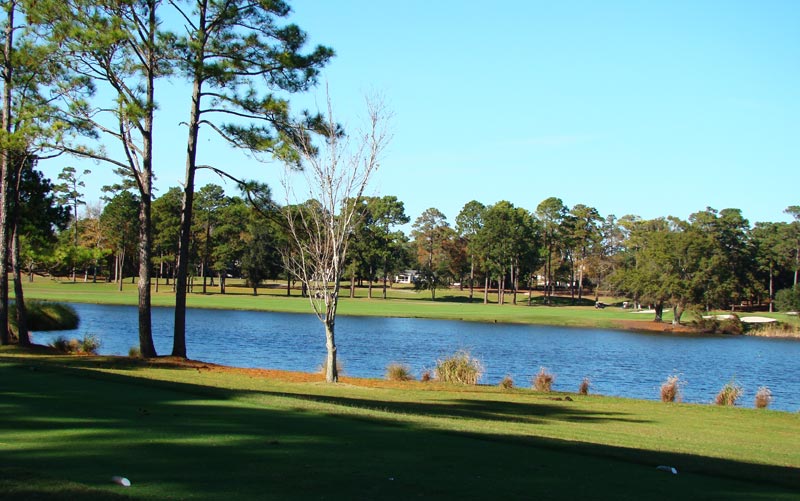
Here are the tees and… there is the green! Jenkins put it best when he said, ‘The only way to reach the green is to charter a boat.’
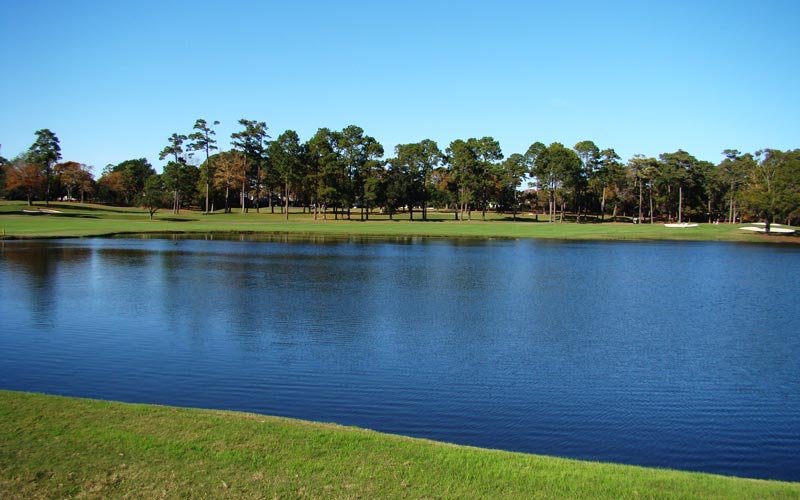
This second shot is why the thirteenth is justly famous and each golfer must make up his own mind as to the correct line. Golfers of less ability aim to the far left in this photograph whereas the tiger might aim close to the far right. Neither player receives much coaching from the architect as to what is the correct path and the resulting doubt often leads to a confused swing.
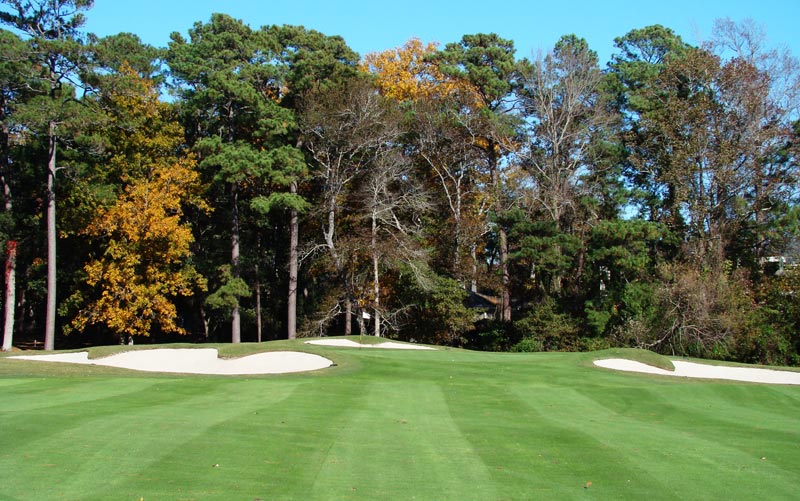
As the green features the boldest interior contours on the course, the golfer feels the pressure to get within 120 yards or so of the green with his second.
Fourteenth hole, 450/410 yards, Homeward Ho; Everyone knows that Jenkins selected the thirteenth when Sports Illustrated published his book on the best holes in America. What most don’t appreciate is that both the twelfth and fourteenth received honorable mention and were nearly included as well. That’s how strong this part of the course is and this hole embodies Jones’s oft quoted line ‘that every hole should be a difficult par and an easy bogey.’ This is high demand architecture as the man in search of a par doesn’t have many options other than to hit a really good drive and then a high soft approach shot to a relatively small target that is fronted by three bunkers. Nonetheless, because of how the tee, landing area and green occupy the high points, it is quite a handsome hole and all golfers enjoy playing it.
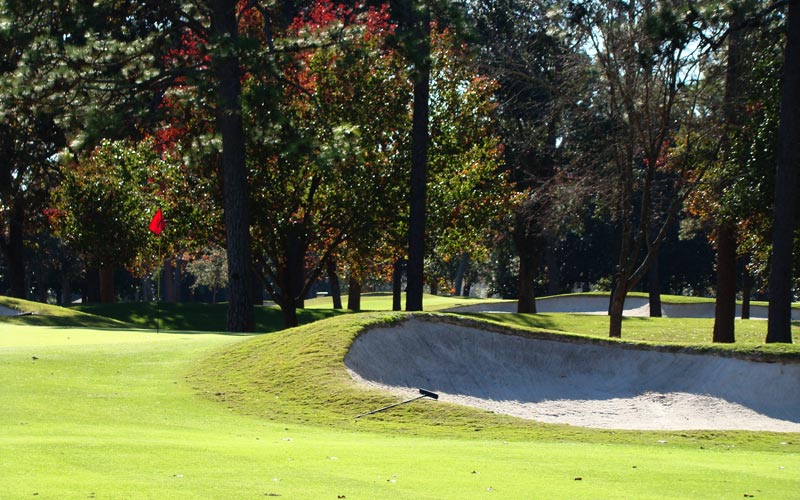
The built up bunker walls obscure targets such as the fourteenth green and make them play all the smaller.
Sixteenth hole, 365/345 yards, Bull’s Eye; Seeing a teaser like this late in the round shows what Jones meant when he remarked ‘every course should be challenging, but it always should be fun to play.’ His sketch of this green and its surrounding bunkers in The Golf Course by Whitten and Cornish is very instructive as to how he visualized and formulated green complexes.
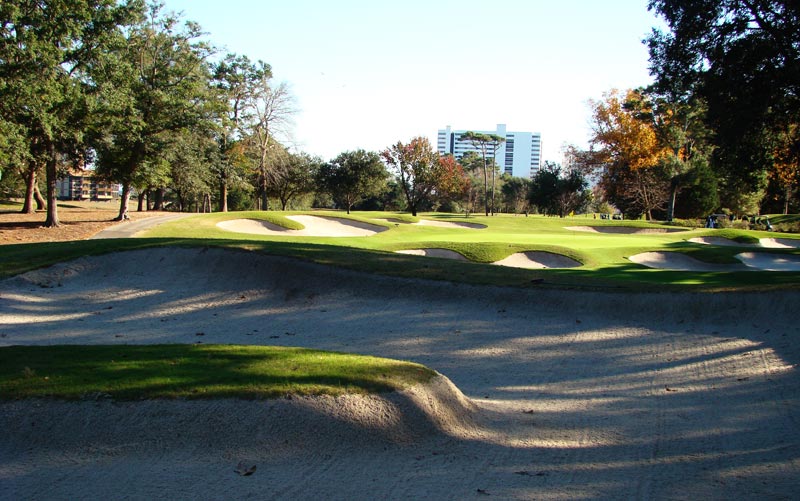
The sixteenth is a placement hole and this fairway bunker with its island needs to be avoided off the tee.
Eighteenth hole, 430/385 yards, Little Gator; One reason that The Dunes garnered favorable reviews from the day it opened is that it was a fresh, original design. Water had not become the ubiquitous hazard that it is now and for the final green to be tightly guarded by a pond was a novelty. The approach shot is farther complicated by the fact that most drives hit into the upslope of the fairway and frequently the golfer doesn’t have a good view of the pond or sometimes even the green itself. Playing an approach from an upslope to a target fronted by water has t-r-o-u-b-l-e written all over it.
Jones’s name is associated with well over four hundred courses (i.e. ten times that of William Flynn for instance). That’s a lot and clearly not all of them received the same amount of personal attention as his design empire grew. However, The Dunes came early on and it enjoyed his full focus with one result being there is nothing close to a weak or throw-away hole here. Also, the course is a delight to walk though many lazy golfers opt for a golf cart instead, ignoring the fact that golf is a walking sport. This is a special course, one of the few great ones built anywhere in the world between 1945 and 1985 and the variety of the greens is better appreciated by approaching them from a distance on foot. Yes, too many greens are bunkered front left and front right (e.g. the first, second, third, fifth, eighth, ninth, tenth, thirteenth, fourteenth, sixteenth, and seventeenth) for this to be confused as a Golden Age design. Still, imbuing this course with genuine ground game options would have been difficult, in part because of the need for pushed up greens and in part because of the grassing schemes dictated by the high humidity in the southeast of the United States. (As an aside, his course at Ballybunion features fescue grasses and consistently firm playing conditions, so he left many more greens open in front).
What was a private wild-turkey and deer-hunting preserve became a course that has stood the test of time for over sixty years as well as any course you can name. Let’s leave the concluding words on this benchmark in design to Jones himself who wrote in Golf’s Magnificent Challenge, ‘I designed the Dunes at Myrtle Beach on a lovely piece of land studded with live oaks where the Singleton Swash empties into the Atlantic Ocean. If it was not a true seaside course, it was as close as I had come to one at that point. I was able to work the water into several holes, including the 13th that became one of the world’s most famous par-5s and perhaps the best example of my philosophy of heroic architecture. Certainly, it was, and still is, one of my landmark courses.’
The End


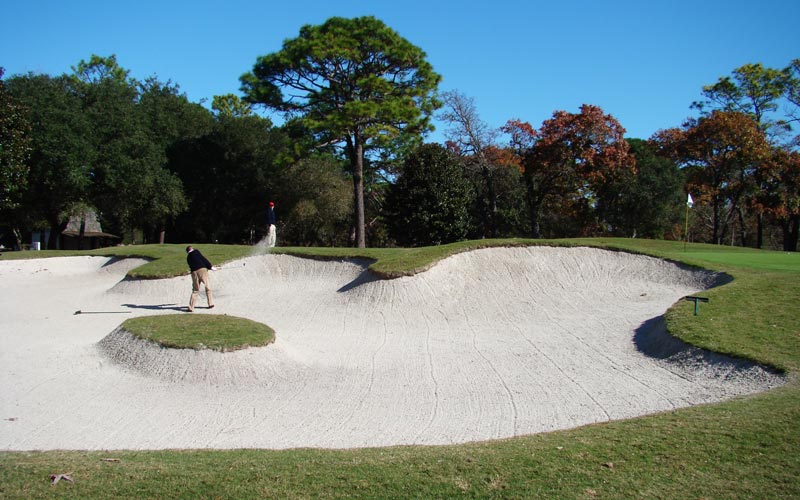
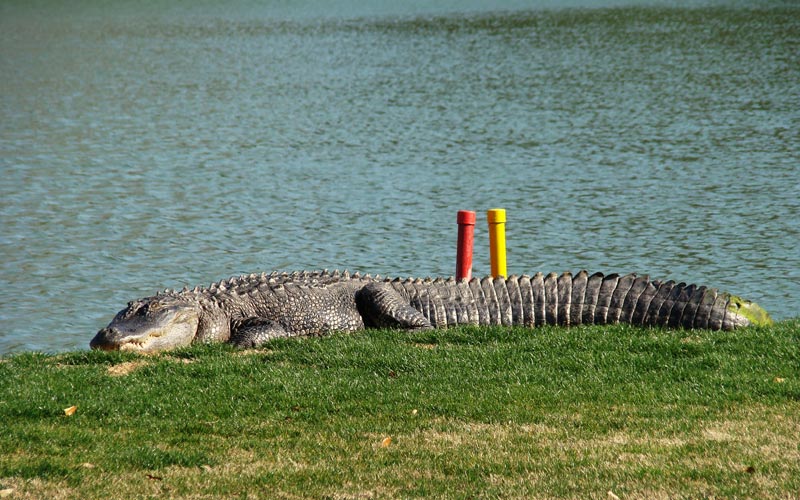
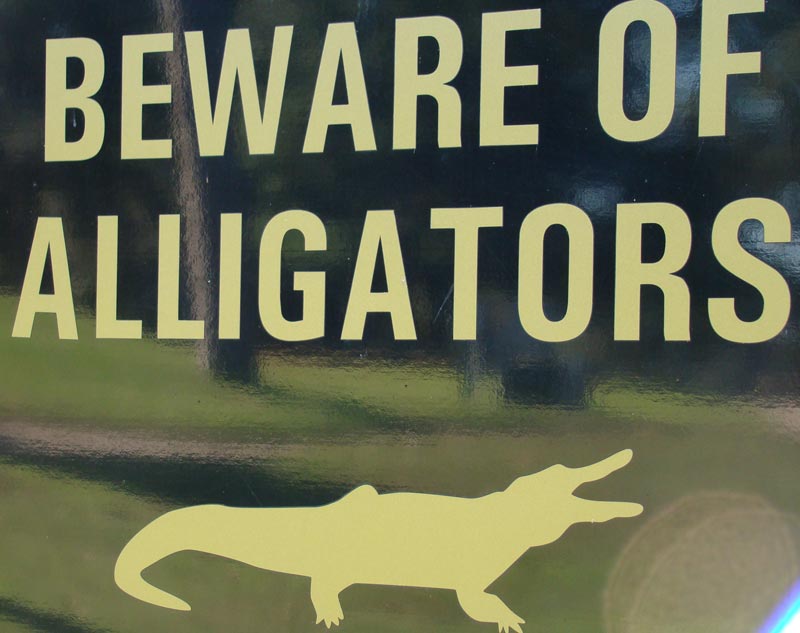
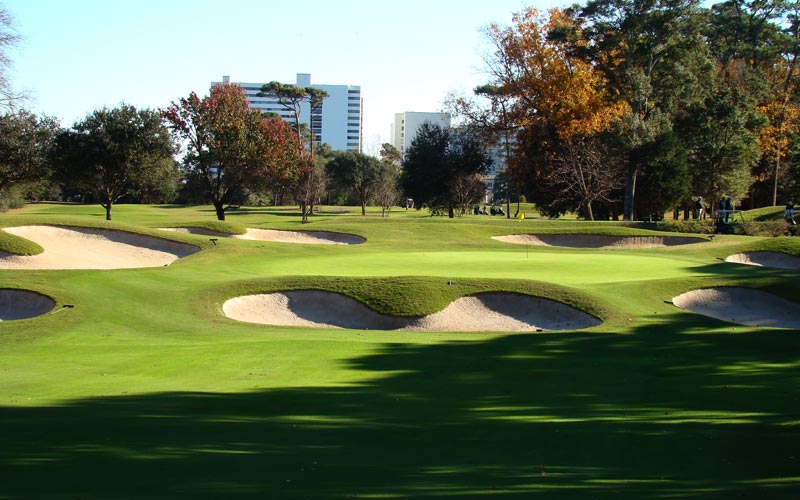
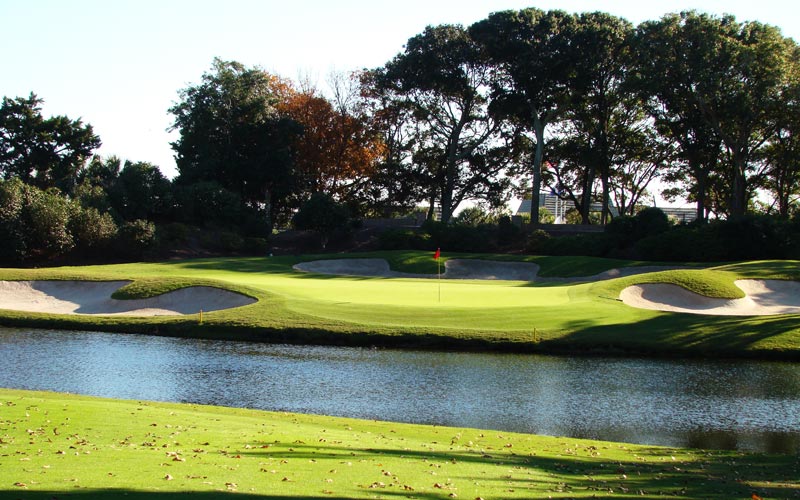



![The Park, West Palm (Lit 9) [2023]](https://golfclubatlas.com/wp-content/uploads/2024/12/IMG_7092-2-scaled-500x383.jpg)


